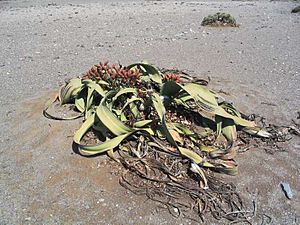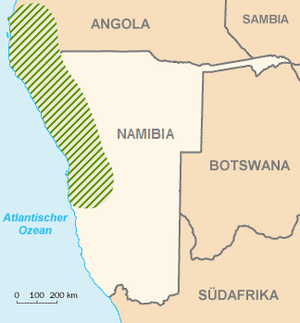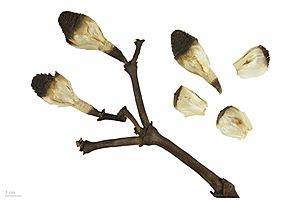Welwitschia facts for kids
Quick facts for kids Welwitschia |
|
|---|---|
 |
|
| Scientific classification | |
 |
|
| Welwitschia's range. | |
| Synonyms | |
|
The Welwitschia (also known as Welwitschia mirabilis) is a truly amazing plant. It is one of the oldest living plants on Earth. Many people call it a "living fossil" because it has been around for so long.
This special plant mostly grows in the dry deserts of Namibia. Some Welwitschia plants might be more than 5000 years old! This incredible age makes them some of the oldest living things on our planet.
Contents
Discovering the Welwitschia
The Welwitschia plant was named after the person who discovered it. His name was Dr. Friedrich Welwitsch. Local people in Namibia have their own name for it. They call it the "long haired thing." This name fits well because of its very long leaves.
What Does Welwitschia Look Like?
The Welwitschia plant has a very unique shape. It has a short, woody stem that looks a bit like a top. This stem stays low to the ground.
Welwitschia's Amazing Leaves
One of the most surprising things about the Welwitschia is its leaves. It only ever grows two leaves in its entire life! These two leaves grow incredibly long, reaching two or three meters (about 6 to 10 feet). Over time, the ends of these long leaves often split and fray. This makes them look like many different leaves.
Where Welwitschia Lives
Welwitschia mirabilis is found only in the Namib Desert. This desert stretches along the coast of Namibia and into parts of Angola. It is a very dry place with little rain.
Adapting to the Desert
The Welwitschia is perfectly suited for its harsh desert home. It gets most of its water from the fog that rolls in from the Atlantic Ocean. Its long leaves help it collect this moisture. The plant's deep root system also helps it find water underground.
Life Cycle of Welwitschia
Welwitschia plants reproduce using cones, much like pine trees. There are male plants and female plants.
Male and Female Cones
Male Welwitschia plants produce small, reddish-brown cones. These cones contain pollen. Female plants produce larger, more open cones. These female cones hold the seeds. Wind helps carry pollen from the male cones to the female cones.
Seeds and New Plants
Once the female cones are pollinated, they develop seeds. These seeds are winged, which helps them spread in the wind. When the seeds land in a good spot, they can grow into new Welwitschia plants. However, it takes a very long time for a new plant to grow big.
Images for kids
-
Cultivated at Huntington Library and botanical garden
See also
 In Spanish: Welwitschia mirabilis para niños
In Spanish: Welwitschia mirabilis para niños












